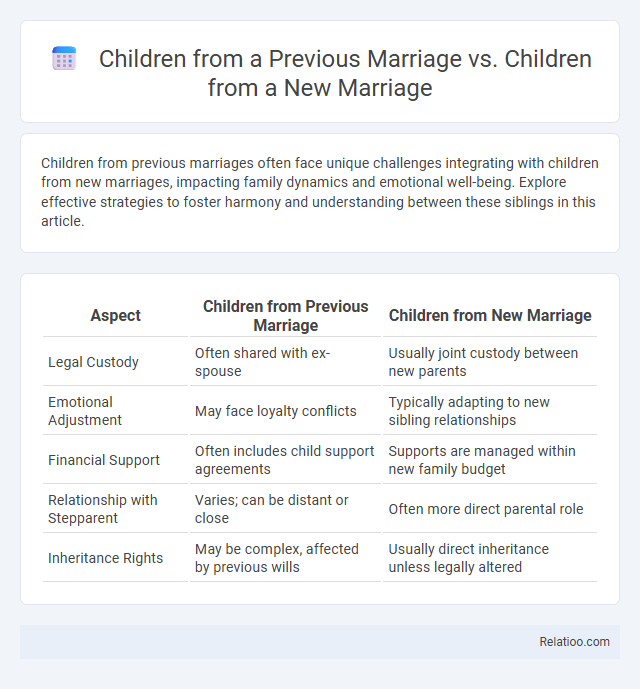Children from previous marriages often face unique challenges integrating with children from new marriages, impacting family dynamics and emotional well-being. Explore effective strategies to foster harmony and understanding between these siblings in this article.
Table of Comparison
| Aspect | Children from Previous Marriage | Children from New Marriage |
|---|---|---|
| Legal Custody | Often shared with ex-spouse | Usually joint custody between new parents |
| Emotional Adjustment | May face loyalty conflicts | Typically adapting to new sibling relationships |
| Financial Support | Often includes child support agreements | Supports are managed within new family budget |
| Relationship with Stepparent | Varies; can be distant or close | Often more direct parental role |
| Inheritance Rights | May be complex, affected by previous wills | Usually direct inheritance unless legally altered |
Understanding Family Dynamics: Blended Families Explained
Blended families consist of children from previous marriages and new marriages, creating unique family dynamics requiring empathy, communication, and respect for each individual's role. Understanding family traditions helps integrate diverse values and customs, fostering harmony and mutual acceptance among step-siblings and parents. Navigating these complex relationships enhances emotional bonds, ensuring a supportive environment for all family members.
Emotional Challenges for Children from Previous Marriages
Children from previous marriages frequently face emotional challenges such as feelings of jealousy, abandonment, and divided loyalty when integrated into new family structures. These children often struggle with adapting to new parental figures while maintaining bonds with their biological parents, creating complex emotional dynamics. Family traditions can either ease or intensify these challenges, as inclusive rituals help foster belonging, whereas exclusion may heighten feelings of alienation.
Integration of Children from New Marriages
Integrating children from new marriages into existing family traditions requires careful balancing of established customs and the needs of all children involved. Research indicates that inclusive practices, such as creating new shared rituals and respecting each child's background, significantly improve family cohesion and reduce conflict. Successful integration depends on open communication, mutual respect, and flexibility in adapting family traditions to embrace blended family dynamics.
Navigating Loyalty Conflicts Among Siblings
Navigating loyalty conflicts among siblings from children of previous and new marriages requires clear communication and empathy to foster a sense of unity while respecting individual family traditions. Your approach should prioritize creating inclusive family rituals that honor both sets of children's backgrounds, helping reduce feelings of favoritism or neglect. Establishing boundaries and encouraging open dialogue aids in aligning expectations and nurturing mutual respect across blended family dynamics.
Parental Roles and Responsibilities in Blended Families
In blended families, parental roles and responsibilities require balancing the needs of children from previous marriages and new marriages, ensuring equal emotional support and consistent discipline. You must navigate complex family dynamics by fostering respect and open communication between all children to uphold a family tradition of unity and stability. Establishing clear boundaries and shared parenting goals helps create an environment where every child feels valued and secure.
Communication Strategies for Family Harmony
Effective communication strategies for families blending children from previous and new marriages center on empathy and active listening to address differing needs and emotions. Establishing clear boundaries and consistent routines helps children feel secure while honoring family traditions fosters unity and respect across generations. You can promote harmony by encouraging open dialogue and validating each child's unique experience within the evolving family dynamic.
Addressing Jealousy and Rivalry: Steps for Parents
Parents confronting jealousy and rivalry between children from previous and new marriages should establish consistent family traditions that include all siblings to foster unity and mutual respect. Clear communication about roles, expectations, and individual needs helps address insecurities and promotes emotional security. Implementing routines where parents spend quality time individually and collectively with each child reduces perceived favoritism and builds stronger family bonds.
Legal and Custodial Considerations
Legal and custodial considerations often prioritize the best interests of the child, regardless of whether they are from a previous or new marriage. Courts evaluate factors such as existing custody agreements, parental responsibilities, and the child's emotional and physical well-being, which can influence custody arrangements and inheritance rights. Family traditions may impact informal caregiving roles but typically hold less weight than statutory laws and legal precedents in custody determinations.
Building Trust and Mutual Respect
Balancing relationships between children from a previous marriage and those from a new marriage requires fostering trust and mutual respect through open communication and consistent fairness. Family traditions serve as a foundation for unity, helping You create shared experiences that bridge differences and strengthen bonds. Prioritizing empathy and honoring each child's individuality cultivates an environment of acceptance and collaborative family growth.
Long-Term Impact on Child Development
Children from previous marriages may face unique emotional challenges such as loyalty conflicts and divided attention, affecting their long-term emotional stability. Children from new marriages often benefit from blended family dynamics that can enhance social adaptability and resilience if managed with consistent support and clear communication. Family traditions, whether preserved or newly established, foster a strong sense of identity and continuity, playing a critical role in a child's emotional security and developmental outcomes over time.

Infographic: Children from Previous Marriage vs Children from New Marriage
 relatioo.com
relatioo.com